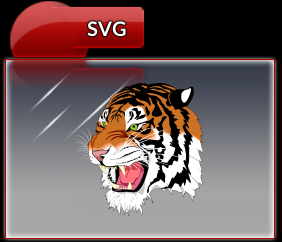SVG plugin
RmlUi comes integrated with the SVG plugin for rendering SVG vector images. The plugin uses the LunaSVG library to render the SVG document.
When RmlUi is built with the SVG plugin, the <svg> element is available as a normal RML tag, in addition to the svg decorator.
The plugin implements a cache for the SVG documents and generated bitmaps. Each SVG document will be stored in the cache as long as it is in use, otherwise the document will be released. For each SVG document, we also cache textures based on their resolution and color. Textures will be reused if all properties that determine their generated bitmap match.
<svg>
The <svg> element is used to include SVG vector images in the document.
Attributes
src= uri (CT)- The source location of the SVG image. If this is not specified, then the inline contents of the
<svg>element will be used as its SVG source. width= number (CN)- The width to force the element to, in pixels.
height= number (CN)- The height to force the element to, in pixels.
crop-to-content(CI)- When set, the SVG view-box will be cropped to the content of the SVG, i.e. the content will be scaled up to remove any whitespace from its edges.

Example
The <svg> element can be used as follows:
<svg src="tiger.svg"></svg>
The following demonstrates the use of an inline SVG document:
<svg width="50" height="50" xmlns="http://www.w3.org/2000/svg">
<circle cx="25" cy="25" r="20" stroke="black" stroke-width="3" fill="red" />
</svg>
Note that the inner parts of the <svg> element is not part of the DOM, i.e. one can not manipulate its sub-elements with the Rml::Element API. However, the SVG source can be updated using Rml::Element::SetInnerRML, or even updated automatically using data bindings and in particular the data-rml view. See the svg sample for details.
Decorator svg
The svg decorator can be used to include an SVG image in the background of an element.
decorator: svg( <svg-src> <crop>? ) <paint-area>?;
Properties
svg-src
| Value: | <string> |
| Initial: | N/A |
| Percentages: | N/A |
The path to the SVG file to display.
crop
| Value: | crop-none | crop-to-content |
| Initial: | crop-none |
| Percentages: | N/A |
Determines how the SVG image is cropped.
crop-none- The SVG image will not be cropped.
crop-to-content- The SVG view-box will be cropped to the content of the SVG, i.e. the content will be scaled up to remove any whitespace from its edges.
paint-area
| Value: | border-box | padding-box | content-box |
| Initial: | padding-box |
| Percentages: | N/A |
Declares the box area to render the decorator onto.
Note that the SVG decorator will always fill the size of the paint area. To preserve the aspect ratio, ensure that the element is appropriately sized.
Example
The svg decorator can be applied as follows:
.tiger {
decorator: svg("tiger.svg");
}
In the following, we set the paint area to the element’s content box to control the padding manually, while skipping any existing padding in the SVG file:
.tiger {
decorator: svg("tiger.svg" crop-to-content) content-box;
padding: 10px 20px;
}
Building with the SVG plugin
The SVG plugin is integrated and built with the Core RmlUi library once it is enabled. Then, the plugin is automatically loaded during the call to Rml::Initialise().
Building LunaSVG
First, we demonstrate how to download and build the required LunaSVG dependency. If you’re using vcpkg, you can install the library with vcpkg install lunasvg, and then go directly to the configuring RmlUi step below. Otherwise, you can build it manually as shown in the following.
Open up a terminal and navigate to RmlUi/Dependencies. Then execute the following commands.
git clone --recurse-submodules --branch v3.2.1 https://github.com/sammycage/lunasvg
cd lunasvg
cmake -B build -S . -DBUILD_SHARED_LIBS=OFF -DLUNASVG_BUILD_EXAMPLES=OFF
cmake --build build --target lunasvg --config Debug
cmake --build build --target lunasvg --config Release
You may need to adjust the CMake arguments to your generator and environment. The plugin is tested at the given version of LunaSVG, but other versions may work.
Configuring RmlUi
Next, during CMake configuration of RmlUi, set the option RMLUI_SVG_PLUGIN=ON. This will ensure that the SVG plugin is integrated and built together with the RmlUi core library. For example, in the RmlUi directory execute the following:
cmake -B Build -S . --preset samples -DBUILD_SHARED_LIBS=OFF -DRMLUI_SVG_PLUGIN=ON
If you built LunaSVG using the above procedure, you may need to additionally add -Dlunasvg_ROOT="Dependencies/lunasvg/build" to the CMake configure command. In some cases, you may need to provide the path to the PlutoVG dependency of LunaSVG as well, e.g.: -Dplutovg_ROOT="Dependencies/lunasvg/build/plutovg".
Once it has been successfully configured, you can now try out the sample for the plugin. Build and run the included rmlui_sample_svg target the same way you would with any other sample.
Including the SVG plugin
To include the SVG plugin in your own project, make sure you build RmlUi with the CMake option RMLUI_SVG_PLUGIN enabled as described above, and integrate RmlUi into your project as normal. In addition, you will need to link with the lunasvg library. For CMake projects, RmlUi should automatically declare the dependency to LunaSVG and link to it. Make sure that LunaSVG can be found by CMake, for example by setting the lunasvg_ROOT variable to its build folder.
The plugin is then automatically loaded during the call to Rml::Initialise(). If everything has worked out properly, the log will output a short message about the SVG plugin being initialised. The <svg> element should then be available for displaying vector images.